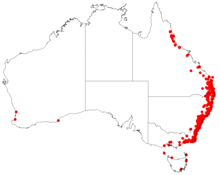| Dusky coral pea | |
|---|---|

| |
| Kennedia rubicunda | |
| Scientific classification | |
| Kingdom: | Plantae |
| Clade: | Tracheophytes |
| Clade: | Angiosperms |
| Clade: | Eudicots |
| Clade: | Rosids |
| Order: | Fabales |
| Family: | Fabaceae |
| Subfamily: | Faboideae |
| Genus: | Kennedia |
| Species: | K. rubicunda |
| Binomial name | |
| Kennedia rubicunda Vent. | |

| |
| Australian occurrence data from Australasian Virtual Herbarium | |
| Synonyms | |
Kennedia rubicunda, commonly known as the dusky coral pea, is a species of flowering plant in the family Fabaceae and is endemic to eastern continental Australia. It is a twining or prostrate herb with trifoliate leaves and dark red or purple flowers.
Description
Kennedia rubicunda is a twining or prostrate herb with stems up to 4 metres (13 ft) long and covered with rusty-brown hairs. The leaves are trifoliate on a petiole 10–50 mm (0.39–1.97 in) long, the leaflets egg-shaped to lance-shaped, 30–120 mm (1.2–4.7 in) long and 20–80 mm (0.79–3.15 in) wide with lance-shaped stipules 2–4 mm (0.079–0.157 in) long at the base of the petiole. Dark red pea flowers are arranged in racemes of up to twelve on a peduncle 20–70 mm (0.79–2.76 in) long, each flower on a pedicel 10–20 mm (0.39–0.79 in) long. The sepals are 10–15 mm (0.39–0.59 in) long and densely covered with rusty-brown hairs and the petals are 30–40 mm (1.2–1.6 in) long. Flowering mostly occurs from September to December and the fruit is a rusty-hairy, flattened pod 50–100 mm (2.0–3.9 in) long containing ten to fifteen seeds.
Taxonomy
Dusky coral pea was first formally described in 1793 by Dutch botanist George Voorhelm Schneevoogt, who gave it the name Glycine rubicunda in his book Icones Plantarum rariorum. In 1804 it was published under its current name by French botanist Étienne Pierre Ventenat in his book, Jardin de la Malmaison. The specific epithet (rubicunda) refers to the species' red flowers.
Distribution and habitat
Kennedia rubicunda is widespread in a variety of habitats, including in forests and rainforest margins, on the coast and nearby tablelands of Queensland, New South Wales and far eastern Victoria. It is an introduced species in India, Tasmania and the North Island of New Zealand (where it is considered a weed).
Ecology
Flowers of K. rubicunda are pollinated by birds. Seed dispersal by ants (myrmecochory) has been reported, in which ants are attracted to fatty acid-rich elaiosomes attached to the outside of the seeds. The plant is killed by bushfire but regenerates from seed dormant in the soil and is often abundant after fire. K. rubicunda forms a symbiosis with soil nitrogen fixing bacteria (rhizobia) resulting in the formation of nodules on the roots that fix atmospheric nitrogen which is used for plant growth.
Use in horticulture
This plant is noted for its vigour and can be used to cover embankments or structures. The species is adapted to a range of well-drained soils and adapts to positions with sun or partial shade. It is resistant to drought and has some frost tolerance. The species can be propagated by scarified seed or cuttings of semi-mature growth.
References
- ^ "Kennedia rubicunda". Australian Plant Census. Retrieved 29 October 2021.
- ^ "Kennedia rubicunda". PlantNET - New South Wales Flora Online. Royal Botanic Gardens & Domain Trust, Sydney Australia. Retrieved 2008-09-25.
- ^ Jeanes, Jeff A. "Kennedia rubicunda". Royal Botanic Gardens Victoria. Retrieved 29 October 2021.
- Wood, Betty. "Kennedia rubicunda". Lucid Keys. Retrieved 29 October 2021.
- Morcombe, Michael (1991). Australia's Wildflowers (Réimpr. ed.). Sydney: The Book Company and Ure Smith Press. p. 26. ISBN 978-0725408732.
- "Glycine rubicunda". APNI. Retrieved 29 October 2021.
- Schneevoogt, George V. (1793). Icones Plantarum Rariorum. Te Harlem: C. Plaat. p. 28. Retrieved 29 October 2021.
- "Kennedia rubicunda". APNI. Retrieved 29 October 2021.
- Ventenat, Étienne P. (1804). Jardin de la Malmaison. Vol. 2. Paris. p. 104. Retrieved 29 October 2021.
- "Kennedia rubicunda". Australian Native Plants Society (Australia). Retrieved 21 November 2024.
- "Kennedia rubicunda". Atlas of Living Australia. Retrieved 29 October 2021.
- Govaerts, R. et al. 2018. "Plants of the World online: Kennedia rubicunda". Board of Trustees of the Royal Botanic Gardens, Kew. Retrieved 2 July 2018.
- NZ Flora Kennedia rubicunda (Schneev.) Vent. Retrieved 2 July 2018
- Wilson, Karen L; Morrison, David A, eds. (2000). Monocots: Systematics and Evolution. doi:10.1071/9780643090149. ISBN 9780643090149.
- Rice, Barbara; Westoby, Mark (1981). "Myrmecochory in sclerophyll vegetation of the West Head, New South Wales". Australian Journal of Ecology. 6 (3): 291–298. Bibcode:1981AusEc...6..291R. doi:10.1111/j.1442-9993.1981.tb01579.x. ISSN 1442-9993.
- O'Hanlon, James C.; Hill, Sarah J.; Andrew, Nigel R. (2019). "Using devitalised seeds in myrmecological research". Austral Entomology. 58 (4): 805–809. doi:10.1111/aen.12399. ISSN 2052-1758. S2CID 182936843.
- Benson, Doug; McDougall, Lyn (1996). "Ecology of Sydney Plant Species Part 4: Dicotyledon family Fabaceae". Cunninghamia. 4 (4): 623. ISSN 0727-9620. Retrieved 9 December 2024.
- Staehelin, Christian; Forsberg, Lennart S.; D'Haeze, Wim; Gao, Mu-Yun; Carlson, Russell W.; Xie, Zhi-Ping; Pellock, Brett J.; Jones, Kathryn M.; Walker, Graham C.; Streit, Wolfgang R.; Broughton, William J. (September 2006). "Exo-Oligosaccharides of Rhizobium sp. Strain NGR234 Are Required for Symbiosis with Various Legumes". Journal of Bacteriology. 188 (17): 6168–6178. doi:10.1128/JB.00365-06. ISSN 0021-9193. PMC 1595362. PMID 16923883.
- Greig, D. (1987). The Australian Gardener's Wildflower Catalogue. Australia: Angus & Robertson. ISBN 978-0207154607.
- ^ Bodkin, Frances (1991). Encyclopaedia Botanica. Australia: Cornstalk Publishing. ISBN 978-0207150647.
| Taxon identifiers | |
|---|---|
| Kennedia rubicunda |
|
| Glycine rubicunda | |
This Phaseoleae-related article is a stub. You can help Misplaced Pages by expanding it. |